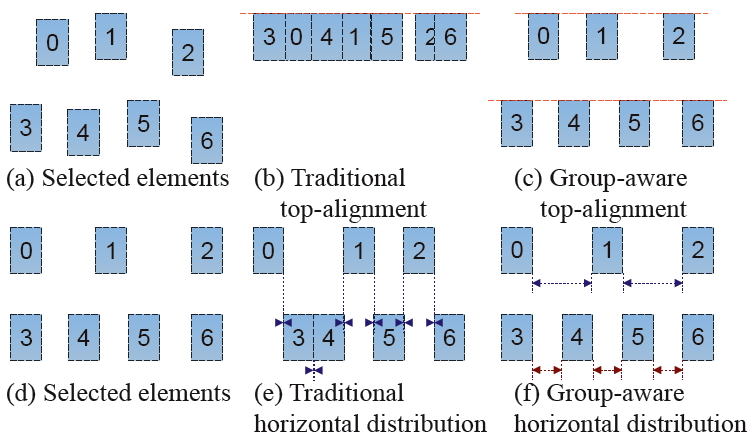
When applied to the same sets of selected elements, our group-aware technique, GACA, achieves more desired results (right) than traditional command-based arrangement (middle).
Abstract
Many graphic applications rely on command-based arrangement tools to achieve precise layouts. Traditional tools are designed to operate on a single group of elements that are distributed consistently with the arrangement axis implied by a command. This often demands a process with repeated element selections and arrangement commands to achieve 2D layouts involving multiple rows and/or columns of well aligned and/or distributed elements. Our work aims to reduce the numbers of selection operation and command invocation, since such reductions are particularly beneficial to professional designers who design lots of layouts. Our key idea is that an issued arrangement command is in fact very informative, instructing how to automatically decompose a 2D layout into multiple 1D groups, each of which is compatible with the command. We present a parameter-free, command-driven grouping approach so that users can easily predict our grouping results. We also design a simple user interface with pushpins to enable explicit control of grouping and arrangement. Our user study confirms the intuitiveness of our technique and its performance improvement over traditional command-based arrangement tools.
Video
Paper
BibTeX
@INPROCEEDINGS{Xu:2015,
author = {Pengfei Xu and Hongbo Fu and Chiew-Lan Tai and Takeo Igarashi},
title = {{GACA}: Group-aware command-based arrangement of graphic elements},
booktitle = {Proceedings of CHI '15},
year = {2015},
}
author = {Pengfei Xu and Hongbo Fu and Chiew-Lan Tai and Takeo Igarashi},
title = {{GACA}: Group-aware command-based arrangement of graphic elements},
booktitle = {Proceedings of CHI '15},
year = {2015},
}
Thanks
We thank the reviewers for their insightful and constructive comments. We also appreciate the user study participants for their time. This work was partially supported by grants from the Research Grants Council of HKSAR, China (Project No. 16209514, 16201315, 113513, 11204014) and JSPS KAKENHI (Grant No. 26240027).